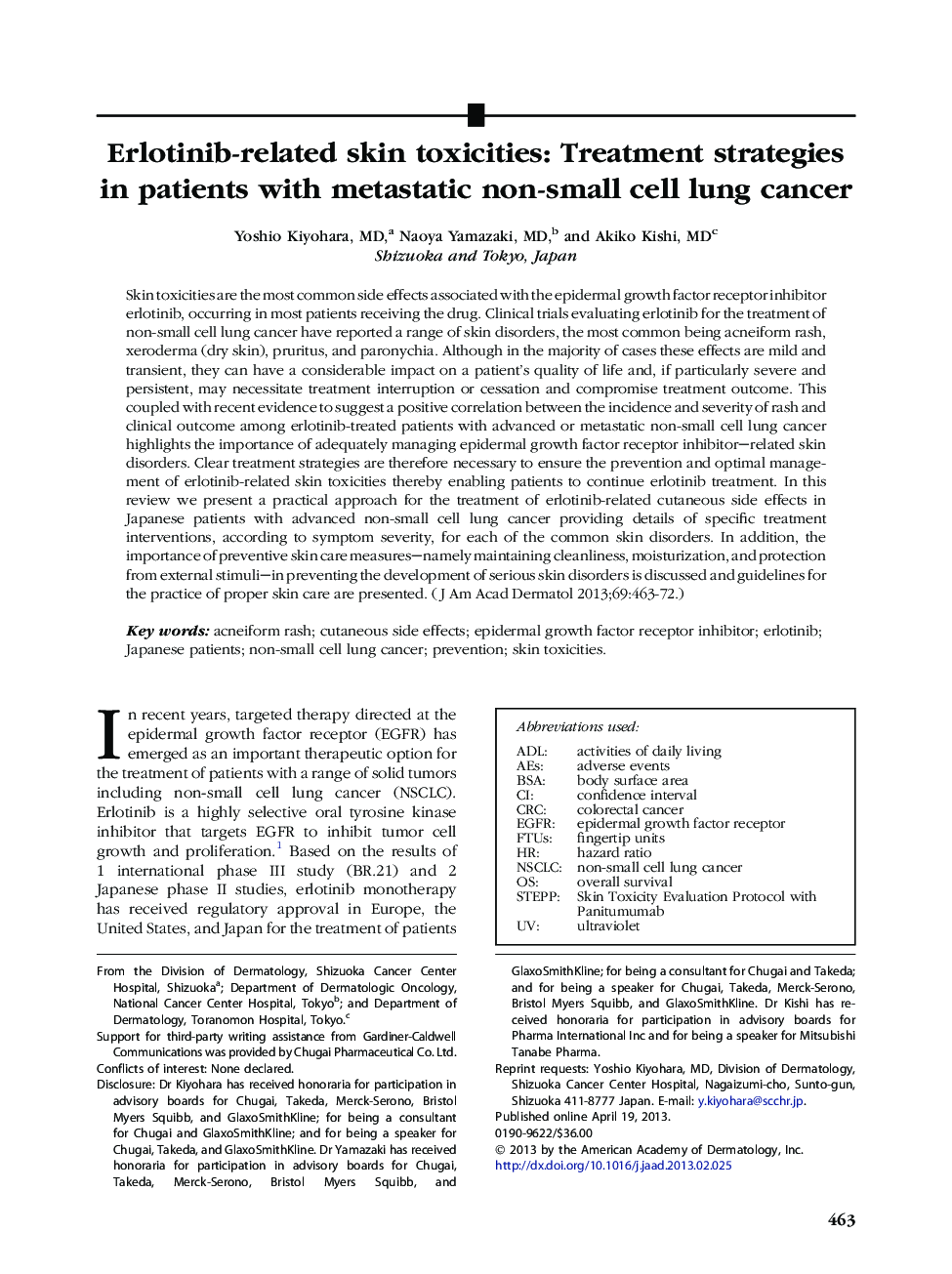| کد مقاله | کد نشریه | سال انتشار | مقاله انگلیسی | نسخه تمام متن |
|---|---|---|---|---|
| 6073812 | 1587547 | 2013 | 10 صفحه PDF | دانلود رایگان |
عنوان انگلیسی مقاله ISI
Erlotinib-related skin toxicities: Treatment strategies in patients with metastatic non-small cell lung cancer
ترجمه فارسی عنوان
سمیت های پوستی مرتبط با ارلتینیب: استراتژی های درمان در بیماران مبتلا به سرطان ریه غیر متاستاتیک سلول های بنیادی
دانلود مقاله + سفارش ترجمه
دانلود مقاله ISI انگلیسی
رایگان برای ایرانیان
کلمات کلیدی
EGFRSTEPPAcneiform rashSkin toxicitiesADLAes - AESBSA - BSAErlotinib - ارلوتینیبUltraviolet - اشعه فرابنفشoverall survival - بقای کلJapanese patients - بیماران ژاپنیColorectal cancer - سرطان روده بزرگNSCLC - سرطان ریوی غیر سلول کوچکNon-small cell lung cancer - سرطان غیر سلول کوچک ریهbody surface area - سطح بدنAdverse events - عوارض جانبیconfidence interval - فاصله اطمینانActivities of daily living - فعالیت های روزمره زندگیepidermal growth factor receptor inhibitor - مهار کننده گیرنده فاکتور رشد اپیدرمیhazard ratio - نسبت خطرPrevention - پیشگیریCRC - کد افزونگی دورهای Epidermal growth factor receptor - گیرنده فاکتور رشد اپیدرمال
ترجمه چکیده
سمیت های پوستی شایع ترین عوارض جانبی مرتبط با مهارکننده گیرنده گندم اپیدرمی ارلوتینیب هستند که در اکثر بیماران دریافت کننده دارو رخ می دهد. آزمایشات بالینی ارلوتینیب برای درمان سلولهای ریه غیر سلولی دارای اختلالات پوستی هستند که شایعترین آنها عبارتند از بثورات آکنه، کسرودرم (پوست خشک)، خارش و پارونیشیا. اگرچه در اکثر موارد این اثرات خفیف و گذرا هستند، اما می توانند تاثیر قابل توجهی در کیفیت زندگی بیمار داشته باشند و اگر به ویژه شدید و ماندگار باشند، ممکن است قطع یا پایان درمان و نتایج درمان مصالحه شود. این در کنار شواهد اخیر نشان می دهد که ارتباط مثبت بین شیوع و شدت بثورات و نتایج بالینی در بیماران مبتلا به ارلوتینیب با سرطان ریه های غیر سلولی پیشرفته یا متاستاتیک، اهمیت به درستی مدیریت اختلالات پوستی مهار کننده گیرنده فاکتور رشد اپیدرمی . بنابراین، استراتژی های واضح درمان برای اطمینان از پیشگیری و مدیریت بهینه از سمیت های پوستی مرتبط با ارلوتینیب ضروری هستند، بنابراین بیماران می توانند به درمان ارلوتینیب ادامه دهند. در این بررسی ما یک رویکرد عملی برای درمان عوارض جانبی جلدی پوستی ارلوتینیب در بیماران ژاپنی با سرطان پیشرفته سلولهای سرطانی غیر سلولی ارائه می دهیم که جزئیات مربوط به مداخلات درمان خاص را براساس شدت عالئم برای هر یک از اختلالات پوستی معمولی ارائه می دهند. علاوه بر این، اهمیت مراقبت های پیشگیرانه مراقبت از پوست - نظیر حفظ پاکیزگی، مرطوب کننده و محافظت از محرک های خارجی - در جلوگیری از ایجاد اختلالات پوستی جدی مورد بحث قرار گرفته و دستورالعمل های مربوط به مراقبت از پوست مناسب ارائه شده است.
موضوعات مرتبط
علوم پزشکی و سلامت
پزشکی و دندانپزشکی
امراض پوستی
چکیده انگلیسی
Skin toxicities are the most common side effects associated with the epidermal growth factor receptor inhibitor erlotinib, occurring in most patients receiving the drug. Clinical trials evaluating erlotinib for the treatment of non-small cell lung cancer have reported a range of skin disorders, the most common being acneiform rash, xeroderma (dry skin), pruritus, and paronychia. Although in the majority of cases these effects are mild and transient, they can have a considerable impact on a patient's quality of life and, if particularly severe and persistent, may necessitate treatment interruption or cessation and compromise treatment outcome. This coupled with recent evidence to suggest a positive correlation between the incidence and severity of rash and clinical outcome among erlotinib-treated patients with advanced or metastatic non-small cell lung cancer highlights the importance of adequately managing epidermal growth factor receptor inhibitor-related skin disorders. Clear treatment strategies are therefore necessary to ensure the prevention and optimal management of erlotinib-related skin toxicities thereby enabling patients to continue erlotinib treatment. In this review we present a practical approach for the treatment of erlotinib-related cutaneous side effects in Japanese patients with advanced non-small cell lung cancer providing details of specific treatment interventions, according to symptom severity, for each of the common skin disorders. In addition, the importance of preventive skin care measures-namely maintaining cleanliness, moisturization, and protection from external stimuli-in preventing the development of serious skin disorders is discussed and guidelines for the practice of proper skin care are presented.
ناشر
Database: Elsevier - ScienceDirect (ساینس دایرکت)
Journal: Journal of the American Academy of Dermatology - Volume 69, Issue 3, September 2013, Pages 463-472
Journal: Journal of the American Academy of Dermatology - Volume 69, Issue 3, September 2013, Pages 463-472
نویسندگان
Yoshio MD, Naoya MD, Akiko MD,
